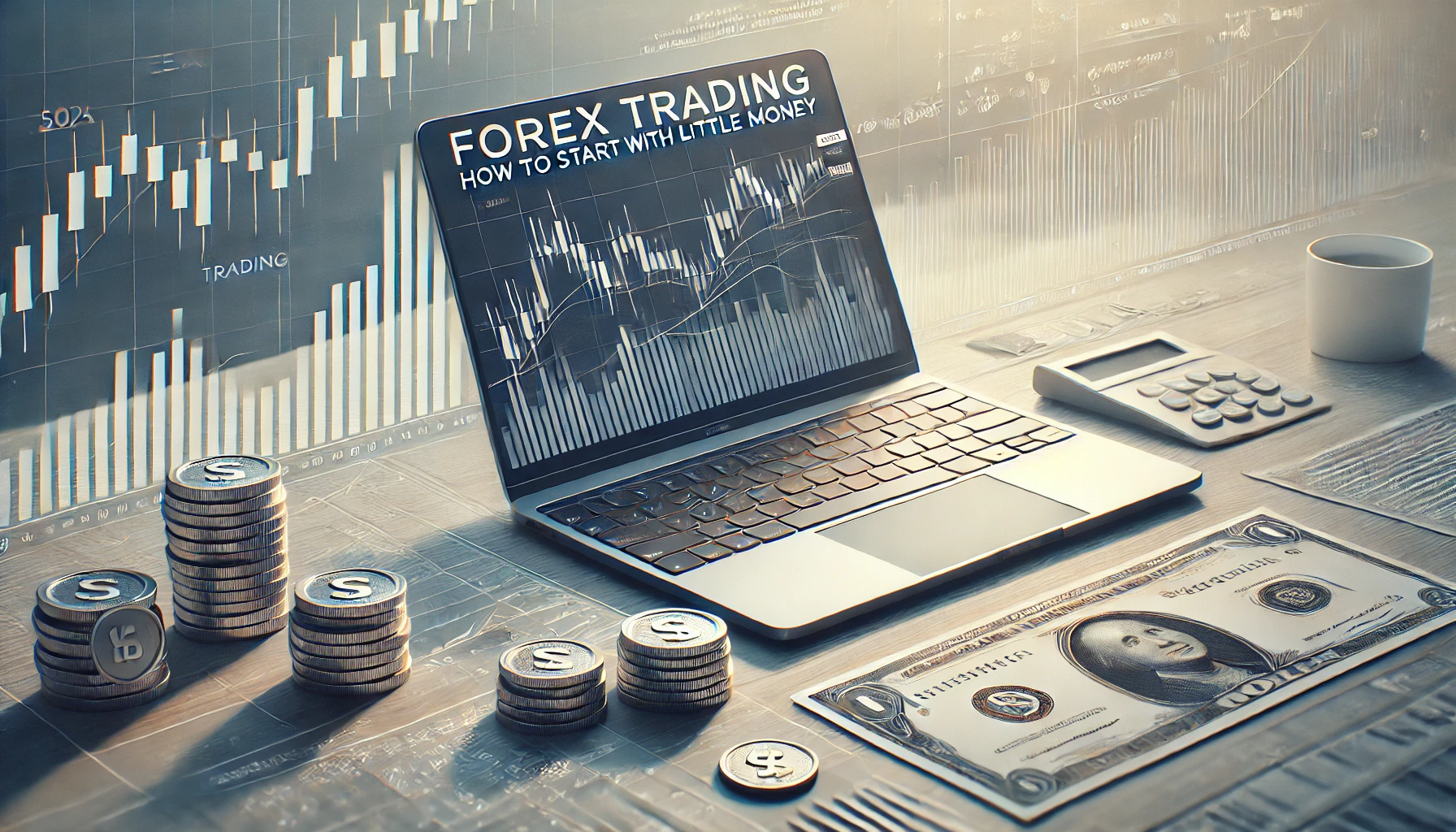How to Start Forex Trading with Little Money
Forex trading, also known as currency trading, offers an exciting opportunity to participate in global currency markets. Many people believe that you need a large starting capital to be successful in forex trading, but that’s not the case. Starting forex trading with little money is not only possible, but it can also be a smart strategy to learn the basics and minimize risks. In this blog post, I will show you how to get started in forex trading with a small amount of capital and the steps you should take to trade successfully. Let’s get started!
What You Need to Know About the Forex Market
Before you start forex trading, it’s important to have a basic understanding of the forex market. The forex market is the largest financial market in the world, where currencies worth trillions of dollars are traded daily. In this market, you always trade in currency pairs, such as Euro/US Dollar (EUR/USD), where you buy one currency and sell another at the same time.
- How Does the Forex Market Work? In the forex market, there are various participants, including banks, governments, companies, and private traders like you. The market is open 24 hours a day, which gives you the flexibility to trade whenever you want. Currency pairs are traded in “pips,” the smallest price change in a currency. The goal is to buy a currency at a lower price and sell it at a higher price.
- Why Is the Forex Market So Attractive? One of the main reasons the forex market is so popular is its high liquidity. This means you can buy and sell currencies almost anytime. Additionally, the forex market allows you to trade with leverage, meaning you can control a larger amount of money with a small amount. While this brings opportunities, it also comes with risks.
A basic understanding of the forex market is crucial to trading successfully. The more you know about market mechanisms, the better you can make informed decisions and minimize your risk.
How to Find the Best Broker for Forex Trading with Little Capital
The next important step when starting forex trading is choosing the right broker. Your broker is your partner in trading, and choosing the wrong one can be costly. Here are some important criteria to consider when selecting a broker, especially if you’re starting with little money.
- Minimum Deposit and Trading Fees: A key factor in choosing a broker is the minimum deposit required. Many brokers offer accounts with a low minimum deposit, which is ideal for starting with little money. Also, pay attention to trading fees, such as spreads and commissions, as these can affect your profits. Here is a comparison of some brokers:BrokerMinimum DepositSpreads (from)LeverageRegulationBroker A€1000.6 pipsUp to 1:30CySECBroker B€2000.4 pipsUp to 1:50FCABroker C€501.0 pipsUp to 1:20ASIC
- Regulation and Security: The safety of your money is paramount. Make sure the broker is regulated by a recognized financial authority. Strong regulation protects you from fraud and ensures that the broker adheres to certain standards.
- Trading Platforms and Tools: Check which trading platforms and tools the broker offers. A user-friendly platform that gives you access to analysis tools and market news is important for effective trading. Some brokers also offer mobile apps that allow you to trade from anywhere.
- Reviews and Testimonials: Read reviews and testimonials from other traders to get a sense of how the broker works in practice. Pay attention to factors such as customer service, execution quality, and fee transparency.
Choosing the right broker is crucial if you want to start forex trading with little money. A good broker will provide you with the necessary tools, low entry barriers, and a secure trading environment to successfully enter the forex market.
Leverage and Risk Management: How to Protect Your Capital
An important aspect of forex trading is the use of leverage. Leverage allows you to trade a larger volume with a small amount of money. This can multiply your profits, but it also carries risks, as losses can also be magnified. Therefore, it is crucial that you implement good risk management to protect your capital, especially if you are starting forex trading with little money.
What Is Leverage? Leverage allows you to trade more money than you actually have in your account. For example, if you use leverage of 1:20, you can control €2,000 in the market with just €100. This means that small price movements can have a significant impact on your profit or loss.
Advantages and Disadvantages of Leverage: Leverage has both advantages and disadvantages. It allows you to achieve significant profits even with little capital. On the other hand, it also increases the risk, as you can lose more money than you have invested.
| Leverage | Advantages | Disadvantages |
|---|---|---|
| 1:10 | Higher profit potential | Increased risk of losses |
| 1:20 | Move more capital in the market | Faster account depletion in case of losses |
| 1:50 | Maximizes potential gains | High volatility and uncertainty |
Risk Management in Forex Trading: Good risk management is essential to limit losses and protect your capital. Here are some tips that can help you:
- Set Stop-Loss Orders: These automatic sell orders help you limit losses by closing your positions if the market moves against you.
- Use Only a Small Portion of Your Capital Per Trade: Invest only a small percentage of your total capital in each trade to spread your risk.
- Avoid Emotional Trading: Stick strictly to your strategy and don’t let short-term market movements or emotions drive your decisions.
Leverage and risk management go hand in hand. By using leverage wisely and implementing solid risk management practices, you can protect your capital and make the most of the opportunities in the forex market.
How to Develop a Profitable Forex Trading Strategy
A successful trading strategy is the cornerstone of every successful trader. Especially if you are starting forex trading with little money, it is important to have a well-thought-out strategy to minimize your risk and maximize your chances of profit.
- Basics of a Forex Trading Strategy: A forex trading strategy outlines when and how you enter the market, how long you hold your positions, and when you close them. It should be based on a combination of technical and fundamental analysis.
- Technical Analysis: In technical analysis, you examine historical price data to identify patterns and trends. Indicators like moving averages or the Relative Strength Index (RSI) can help you make better trading decisions.
- Fundamental Analysis: This involves looking at economic and political events that can affect the value of a currency. News about interest rates, employment data, or geopolitical developments can provide important clues about where a currency pair might be headed.
- Examples of Simple Trading Strategies: One example of a simple trading strategy is the Moving Average Crossover strategy. In this strategy, you buy when a short-term moving average crosses above a long-term moving average and sell when the opposite occurs.Trading StrategyEntry SignalExit SignalTime FrameMoving Average CrossoverWhen the short-term MA crosses above the long-term MAWhen the short-term MA crosses below the long-term MA1 hourRSI (Relative Strength Index)RSI falls below 30 (oversold)RSI rises above 70 (overbought)4 hours
- Using a Demo Account to Test: Before investing real money in the market, you should test your strategy in a demo account. A demo account simulates the real market, but you trade with virtual money. This allows you to refine your strategy without any risk.
Developing and applying a solid trading strategy is crucial to being successful in the forex market. With the right strategy and enough practice, you can consistently earn profits even with little capital.
Why a Demo Account Is Your Best Friend
If you are new to forex trading, a demo account is your best friend. It gives you the opportunity to learn about the market and test various trading strategies without risking real money. Especially when starting forex trading with little money, a demo account is essential to ensure that you are well-prepared before putting real capital at risk.
- Advantages of a Demo Account:
- No Financial Risk: Since you trade with virtual money, you can focus entirely on learning without the fear of losing money.
- Realistic Market Conditions: A demo account mirrors real market conditions, allowing you to practice in a realistic environment.
- Test Different Strategies: You can try out various trading strategies and find out which one suits you best without risking real money.
- How to Use a Demo Account Effectively: Use the demo account to familiarize yourself with the trading platform and explore features such as order placement and analysis tools. Experiment with different leverage levels and observe how small market movements affect your positions.Time PeriodTradesWinning TradesLosing TradesTotal ReturnJanuary – March5030 (60%)20 (40%)+8%April – June4528 (62%)17 (38%)+10%July – September4022 (55%)18 (45%)+6%
A demo account is a valuable tool to sharpen your skills and gain confidence in your trading strategy. By making full use of the demo account, you will be better prepared to enter the real market with real money and trade successfully.
Mistakes You Should Avoid in Forex Trading
When you are starting forex trading with little money, it’s important to avoid common beginner mistakes. These mistakes can quickly deplete your capital and affect your motivation. Here are some common mistakes and tips on how to avoid them.
- Overtrading: Overtrading happens when you make too many trades in a short period. This can occur if you try to recover losses quickly or become too greedy. Overtrading increases the risk of making mistakes and overloading your account.How to Avoid Overtrading:
- Set a daily trading limit.
- Stick to your strategy and only trade when the conditions are right.
- Take regular breaks to keep a clear mind.
- Ignoring Stop-Loss Orders: A stop-loss order helps you limit losses by automatically closing your position if the market moves against you. Many beginners don’t set stop-loss orders, which can lead to significant losses.How to Set a Stop-Loss Order Correctly:
- Determine in advance how much you are willing to lose and set the stop-loss accordingly.
- Place the stop-loss not too tight, giving you room for market fluctuations.
- Regularly review whether your stop-loss settings are still appropriate.
- Emotional Decisions: Emotions can lead to irrational decisions, especially if you’ve just suffered losses. It’s important to stay calm and objective, even when the market is unpredictable.How to Avoid Emotional Decisions:
- Create a clear trading plan and stick to it.
- Understand that losses are part of trading and should not be taken personally.
- Use a demo account to train your emotional stability.
- Using Too Much Leverage: Many beginners use too much leverage to achieve larger gains. However, this can also greatly increase losses and quickly drain your account.How to Choose the Right Leverage:
- Start with moderate leverage, such as 1:10 or 1:20.
- Increase leverage only when you feel confident and have gained experience.
- Always remember that higher leverage also means higher risk.
By avoiding these mistakes, you can significantly improve your chances of long-term success in forex trading and protect your capital.
Think Long-Term: The Key to Sustainable Success in Forex Trading
The forex market can be very tempting, especially when you see quick profits. But to be truly successful, you need to think long-term. Starting forex trading with little money requires patience, discipline, and the willingness to continuously learn.
- Why Long-Term Thinking Is So Important: Short-term gains are tempting but often unstable. Long-term success in forex trading is based on a solid plan, consistent application of strategies, and continuous learning. If you are patient and don’t get discouraged by short-term setbacks, you will be profitable in the long run.
- Set Realistic Goals: Many beginners make the mistake of expecting unrealistic profits in a short period. This often leads to disappointment and increased risk. Instead, set realistic, achievable goals. For example, you might aim to increase your capital by 2-5% per month.Starting CapitalMonthly Return (5%)Capital After 12 Months€100€5€179.59€500€25€897.95€1,000€50€1,795.86
- Learn from Every Trade: Every trade, whether successful or not, offers a learning opportunity. Analyze what went well and what could be improved. Over time, you will develop a deep understanding of the market and become a better trader.
- Be Patient and Disciplined: Success in forex trading doesn’t come overnight. It requires time, discipline, and the ability to stay calm, even when the market is unpredictable. Avoid making impulsive decisions and stick to your strategy.
Long-term thinking is the key to being successful in the forex market. If you are patient, set realistic goals, and continuously learn, you will gradually grow your capital and achieve sustainable profits.
Conclusion: Your Path to Successful Forex Trading
Forex trading offers exciting opportunities to participate in the global currency market, even with little money. The key to success, however, lies in proper preparation and strategy. By understanding the basics of the forex market, choosing a reputable broker, using leverage cautiously, and implementing good risk management, you lay the foundation for successful trades.
A solid trading strategy and the use of a demo account will help you trade more confidently and successfully. Avoid common beginner mistakes, think long-term, and set realistic goals. This way, you will not only maximize your profits but also minimize your risk and achieve long-term success in the forex market.
Now that you know the essential steps, it’s time to get started. Begin with a demo account, develop your strategy, and proceed carefully on your path in forex trading. Your success is in your hands – start today!







